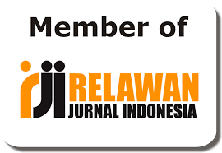Jenis matematika yang sesuai bagi siswa yang bekerja di doorsmeer dalam menyelesaikan masalah matematis: Sebuah diskusi tentang matematika informal siswa
What kind of mathematics for doorsmeer student fits for in solving a mathematical problem: A discussion about student’s informal mathematics
Abstrak
This research aims to identify student’s informal mathematics and how teachers’ response toward it. This research involved 5 (five) teachers in Junior high school and 1 (one) student in Junior high school who work in doorsmeer company (washing motorbike company). For example, in this research, a doorsmeer student (working for washing motorbike) mathematics, which is considered out of school mathematics (informal mathematics), can solve a daily mathematical problem. However, formal mathematics, which uses by teachers, cannot reach reality solution for the student, even the algorithm is correct. In conclusion, mathematics teachers’ thought that mathematics at school fits for doorsmeer student which means it can be applied in the work of doorsmeer company. However, the way how mathematics by doorsmeer student implemented is not the same of mathematics that teachers’ tough fits for the students.
##plugins.generic.usageStats.downloads##
Referensi
Alrø, H., Ravn, O., & Valero, P. (2010). Inter-viewing Critical Mathematics Education. In H. Alrø, O. Ravn, & P. Valero (Eds.), Critical Mathematics Education: Past, Present and Future (pp. 1–9). Sense Publishers.
Braathe, H. Jø. (2015). The New Specialized Norwegian Teacher Education. For the Learning of Mathematics, 35(1), 39–41.
Carraher, T. N., Carraher, D. W., & Schliemann, A. D. (1993). Street Mathematics and School Mathematics. Cambridge University Press.
Cetinkaya, B., Kertil, M., Erbas, A. K., Korkmaz, H., Alacaci, C., & Cakiroglu, E. (2016). Pre-service Teachers’ Developing Conceptions about the Nature and Pedagogy of Mathematical Modeling in the Context of a Mathematical Modeling Course. Mathematical Thinking and Learning, 18(4), 287–314. https://doi.org/10.1080/10986065.2016.1219932
Clements, D. H., & Sarama, J. (2016). Math, science, and technology in the early grades. Future of Children, 26(2), 75–94. https://doi.org/10.1353/foc.2016.0013
Creswell, J. W. (2012). Educational Research: Planning, Conducting, and Evaluating Quantitative and Qualitative Research. Pearson.
Creswell, J. W., & Creswell, J. D. (2018). Research Design Qualitative, Quantitative, and Mixed Methods Approaches (Fifth Edition) (Fifth Edit). Kluwer Academic Publishers.
Culligan, K., & Wagner, D. (2018). This is Not Mathematics. For the Learning of Mathematics, 38(2), 14–18.
D’Ambrosio, U. (1985). Ethnomathematics and Its Place in the History and Pedagogy of Mathematics. For the Learning of Mathematics, 5(1), 44–48.
D’Ambrosio, U. (2001). Ethnomathematics: Link between Traditions and Modernity. Sense Publishers.
D’Ambrosio, U. (2016). An Overview of the History of Ethnomathematics. In Current and future perspectives of ethnomathematics as a program. In ICME-13, Current and Future Perspectives of Ethnomathematics as a Program (pp. 5–10). https://doi.org/10.1007/978-3-319-30120-4
Fellus, O., & Glanfield, F. (2019). What Makes a Mathematician? For the Learning of Mathematics, 39(1), 26–27.
Gadanidis, G. (2012). Why Can’t I Be a Mathematician? For the Learning of Mathematics, 32(2), 20–26.
Gerdes, P. (1994). Reflections on Ethnomathematics. For the Learning of Mathematics, 14(2), 19–22.
Horsthemke, K. (2006). Ethnomathematics and Education: Some Thoughts. For the Learning of Mathematics, 26(3), 15–19. http://www.jstor.org/stable/40248542%5Cnfiles/406/Horsthemke - 2006 - Ethnomathematics and Education Some Thoughts.pdf
Hottinger, S. N. (2016). Inventing the Mathematician: Gender, Race, and Our Cultural Understanding of Mathematics. State University of New York Press.
Huang, J., Normandia, B., & Greer, S. (2005). Communicating Mathematically: Comparison of Knowledge Structures in Teacher and Student Discourse in a Secondary Math Classroom. Communication Education, 54(1), 34–51. https://doi.org/10.1080/14613190500077002
Mamolo, A. (2018). Perceptions of social issues as contexts for secondary mathematics. Journal of Mathematical Behavior, 51(December 2017), 28–40. https://doi.org/10.1016/j.jmathb.2018.06.007
Marcelina, T., Sujadi, I., & Pramesti, G. (2017). Upaya Meningkatkan Motivasi Belajar Siswa Kelas XI IPA 1 SMA Negeri Gondangrejo Pada Mata Pelajaran Matematika dengan Menerapkan Model A RCS (Attention, Relevance, Confidence and Satisfaction). Jurnal Pendidikan Matematika Dan Matematika SOLUSI, 1(3), 32–41.
Morgan, C. (2014). Social Theory in Mathematics Education: Guest Editorial. Educational Studies in Mathematics, 87(2), 123–128. https://doi.org/10.1007/s10649-014-9572-0
Namkung, J. M., Peng, P., Goodrich, J. M., & Molfese, V. (2019). Exploring Growth Trajectories of Informal and Formal Mathematics Skills Among Prekindergarten Children Struggling with Mathematics. Learning Disability Quarterly, 42(2), 80–91. https://doi.org/10.1177/0731948718786030
NCTM. (2014). Principles to Action: Ensuring Mathematical Success for All. NCTM.
Novita, R., & Herman, T. (2021). Using technology in young children mathematical learning: A didactic perspective. Journal of Physics: Conference Series, 1957(1). https://doi.org/10.1088/1742-6596/1957/1/012013
Orey, D. C., & Rosa, M. (2008). Ethnomathematics and Cultural Representations: Teaching in Highly Diverse Contexts. Acta Scientiae, 10(1), 27–46.
Pais, A., Fernandes, E., Matos, J. F., & Alves, A. N. A. S. (2012). Recovering the Meaning of “critique” in Critical Mathematics Education. For the Learning of Mathematics, 32(1), 28–33.
Palmer, M. A. (2010). Situated Mathematical Research: The Interaction of Academic and Non-Academic Practice. For the Learning of Mathematics, 30(2), 32–39.
Philipp, R. A. (1996). Multicultural Mathematics and Alternative Algorithms. Teaching Children Mathematics, 3(3), 128–133.
Putra, M. (2018). How Ethnomathematics can Bridge Informal and Formal Mathematics in Mathematics Learning Process at School: A Framework. For the Learning of Mathematics, 38(3), 11–14.
Putra, M. (2020). Discourse toward Revising Mathematics Curriculum in Indonesia from Six Universal Mathematical Activities ’ Perspective. The 2nd International Conference on Elementary Education: Global Perspective on 21st Elementary Education, 2, 138–151.
Reuben Hersh. (2001). What is Mathematics, Really? Jonathan Cape.
Rogers, P. (2015). Uncritical Ethnomathematics: A Dangerous Pedagogical Approach? For the Learning of Mathematics, 35(2), 25–26.
Skovsmose, O. (1994). Towards a Critical Mathematics Education. Educational Studies in Mathematics, 27(1), 35–57. http://www.jstor.org/stable/3482665
Tomaz, V. S., & David, M. M. (2018). Mathematical Artifacts as Communicational Facilitators between Indigenous and Non-Indigenous Cultures. For the Learning of Mathematics, 38(3), 2–11.
Tunstall, L., & Ferkany, M. (2017). The Role of Mathematics Education in Promoting Flourishing. For the Learning of Mathematics, 37(1), 25–28.
Waege, K. (2010). Motivation for Learning Mathematics in Terms Needs and Goals. In V. Durand-Guerrier, S. Soury-Lavergne, & F. Arzarello (Eds.), Proceedings of the Sixth of the European Society for Research in Mathematics Education (p. 86). Institute National de Recherche Pedagogique.
Walshaw, M. (2014). Who Can Know Mathematics? For the Learning of Mathematics, 34(2), 2–6.





















